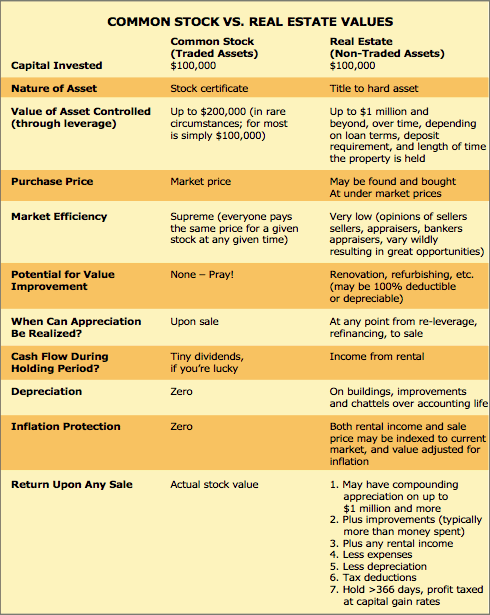Common Stock v Stock
Post on: 13 Июль, 2015 No Comment

We’ve all heard the terms common and preferred stock. Are the common shares for retail, Blue Collar Investors while the preferred shares for the Wall Street insiders? Not exactly. They are both types of stock that a corporation may issue. Let’s clarify the difference.
Definitions :
Common Stock — This is a security that represents ownership in a corporation. It allows you to elect members of a Board of Directors and vote on corporate policy. This is the first type of stock a corporation would issue. Not all corporations issue preferred stock.
Preferred Stock (also called preferreds) This is a class of ownership in a corporation that has a higher claim on the assets and earnings than common stock. It is usually associated with a dividend that must be paid before dividends to common shareholders (that’s us) and these shares do NOT have standard voting rights. The structure of preferred stock is specific to each corporation. It differs from common stock in that it contains characteristics of both debt (fixed dividends) and equity (appreciation potential). These shares are established by companies that already have common shares and are intended for investors who are more interested in income than capital appreciation- the same type of investors who may otherwise purchase bonds.
Advantages of Common Stock.
- Voting rights
- Outperform bonds and preferred shares in the long run
- Easy to manage without an expert
- Can be used for covered call writing
- Free information is easily accessible
Advantages of Preferred Stock :
- Preference over common shareholders in receiving dividends
- Preference over common shareholders with liquidation rights
- Dividend rights are often cumulative (if unpaid one year, it is made up at a later date)
- Most have a negotiated fixed dividend amount
- Many have a convertible feature wherein they can be traded for common shares
- Good compromise between common stocks and bonds
- Liquidity- most trade in round lots of 100 shares on the NYSE and NASDAQ
- Tax advantages- currently taxed @ 15% (as opposed to ordinary income), part of Busch tax reduction which may expire on December 31, 2010.
Disadvantages of Preferred Stock :
- Minimal voting rights (only in unusual circumstances like a merger)
- Callability — most preferreds can be called at a specified price after a certain date that may leave us looking for a replacement investment in a declining interest rate environment.
- Interest rate risk- value will rise and fall with changes in interest rates, similar to longer term bonds.
- Credit risk- if a company’s fundamentals decline an issuer may eliminate a preferred dividend before defaulting on debt.

Practical Application :
It is relatively easy to access both fundamental and technical information when evaluating common shares. This is not the case with preferred shares. First of all, there is no official preferred stock rating system as there is with bonds. You need to ascertain if the company is financially healthy and where it stands with respect to cash. We need to know that it has the cash to pay us those dividends. To evaluate this, we look at the company’s financial ratios like the interest coverage ratio. This will tell us how easily a company can pay interest on outstanding debt. A free site that will give some information related to this subject is:
www.quantumonline.com
Furthermore, symbols are tricky, data is hard to locate and many brokers do not specialize in this area. For most retail investors interested in investing in preferred shares locating a broker knowledgeable in this arena may be the safest route to take. Schwab (www.schwab.com ) has a good reputation in this regard.
How to locate a list of preferred stock from the IBD website :
IBD- Get Preferred Stock List
1- Go to IBD Homepage (www.investors.com )
2- Look to “My Routine” Box on upper right
3- If “other IBD data” is not in this box, click on “modify”
4- Move “other IBD data” from “categories box” to “my routine” box
5- Click on “other IBD data”
6- Click on “futures options and other data”
7- Scroll down to list of preferred stock
8- Use the magnifier at the top toolbar to increase the size of the print (I use 400x)
Conclusion :
One of the mission statements of Blue Collar Investing is to be (more than) well-informed before investing your hard-earned money. Whether you are writing covered calls, purchasing preferred shares, equities or bonds, you must know and understand the product and the risks associated with them. Covered call writing is my passion but preferred shares offer a hybrid investment between stocks and bonds that may be appropriate for some investors.
I will be presenting a FREE seminar on Tuesday July 12th @ 7PM for the Long Island Stock Traders Meetup Group. The topic is “Using Covered Call Writing to Increase Dividend Yield of High Dividend Yield Stocks”. You do not need to be a member of this club to attend. It will be held in a huge state-of-the-art auditorium at The Plainview-Old Bethpage Public Library:
999 Old Country Road
Plainview, NY 11803
Hope to see you there.
The market had a stellar week with predominantly negative economic reports. Go figure!:
- The Conference Boards index of consumer confidence dipped to its lowest level since November
- Construction spending fell 0.6% in May
- Consumer spending was flat in May after a 0.3% rise in April.
- The ISM manufacturing index rose more than expected in June climbing from 53.5 in May to 55.3
For the week, the S&P 500 jumped 5.6% for a year-to-date return of 7.6%.
A 3-month chart of the S&P 500 compared with the VIX shows a sideways moving market and a declining VIX but in an uncomfortable volatile manner:
The S&P 500 vs. the VIX as of 7-2-11
Note the following:
- The S&P 500 has been flat @ + 0%- red arrow
- The S&P 500 has been up 2.5% and down 5% during this 3-month time frame- yellow highlighted area
- The VIX is down 8% in the past 3 months- green arrow
- The VIX has been up as much as 30% and as down as much as 15%- red lines














